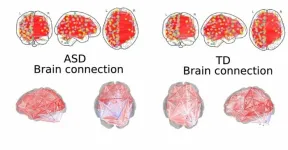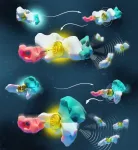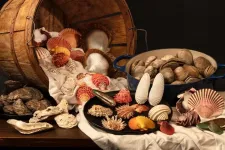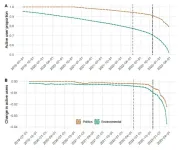(Press-News.org) Diagnosing autism spectrum disorder (ASD) is still a daunting challenge because of the degree of complexity involved, requiring highly specialized professionals. Autism is a multifactorial neurodevelopment disorder with widely varying symptoms. In the United States, about 1 in 36 children have been diagnosed with ASD, according to the Centers for Disease Control and Prevention (CDC), and yet there are no biochemical markers to identify it with precision. A quantitative diagnostic method is proposed by Brazilian researchers in an article published in the journal Scientific Reports.
The study was based on brain imaging data for 500 people, about half of whom (242) had been diagnosed with ASD. Machine learning techniques were applied to the data. “We began developing our methodology by collecting functional magnetic resonance imaging [fMRI] and electroencephalogram [EEG] data,” said Francisco Rodrigues, last author of the article. He is a professor at the University of São Paulo’s Institute of Mathematics and Computer Science (ICMC-USP) in São Carlos, Brazil, and his contribution to the research was supported by FAPESP.
“We compared maps of people with and without ASD and found that diagnosis was possible using this methodology,” Rodrigues said.
The researchers fed a machine learning algorithm with these maps. Based on the learned examples, the system was able to determine which brain alterations were associated with ASD with above 95% accuracy.
Much recent research proposes methods for diagnosing ASD based on machine learning but uses a single statistical parameter, ignoring brain network organization, which is the innovation featured by this study, the article notes. Brain maps or cortical networks show how brain regions are connected. Research on these networks began about 20 years ago and has offered a new vision of neuroscience. “Just as a road with interruptions alters the traffic in a region, a brain with alterations leads to changes in behavior,” Rodrigues said.
The analysis of fMRI data highlighted changes in certain brain regions associated with cognitive, emotional, learning and memory processes. The cortical networks of ASD patients displayed more segregation, less distribution of information and less connectivity compared to controls.
“Until a few years ago, little was known about the alterations that lead to the symptoms of ASD. Now, however, brain alterations in ASD patients are known to be associated with certain behaviors, although anatomical research shows that the alterations are hard to see, making diagnosis of mild ASD much harder. Our study is an important step in the development of novel methodologies that can help us obtain a deeper understanding of this neurodivergence,” Rodrigues said.
The methodology is under development and will take years to implement. Nevertheless, it will contribute to the understanding of cerebral differences and will be useful in future to assist specialists, especially in cases involving diagnostic uncertainty.
A wide range of applications
For Rodrigues, the study is a small contribution to a deeper understanding of how ASD relates to brain alterations. Much more research is needed for this automatic diagnostic method to be put into practice. Brain mapping can be useful to diagnose other conditions apart from ASD. Previous work shows that brain maps can also be used to detect schizophrenia with considerable accuracy.
“We began developing novel methods to identify mental disorders a decade ago. We found that the diagnosis of schizophrenia can be much improved using brain networks and artificial intelligence. We also recently studied use of the methodology to investigate Alzheimer’s disease and found accurate automatic diagnosis to be possible,” Rodrigues said, referring to a study reported in 2022 in the Journal of Neural Engineering.
Many challenges have to be surmounted, such as small databases and the difficulty of collecting data, but as a general methodology it can help scientists understand several conditions, and one of the group’s goals is investigating the relationships among mental disorders.
“How similar in terms of brain alterations are schizophrenia and Alzheimer’s? If we can find correlations between mental disorders, we may be able to develop novel medications and similar treatments for different conditions, or even adapt treatment for one condition to use in another. We’re a long way from this, but the path ahead is promising,” Rodrigues said.
The researchers expect a better understanding of how brain alterations influence behavior to lead to more humane and efficient treatment as well as more effective public policies. The complexity of the subject is evident from the interdisciplinary nature of the research involved. The group comprised physicists, statisticians, physicians and neuroscientists from centers in Brazil, France and Germany. They analyzed medical data compiled by neurologists and brain imaging studies by neuroscientists, as well as algorithms developed by physicists and statisticians.
The study was part of the PhD research of Caroline Alves, first author of the article. Her background is in physics, physical and biomolecular sciences, and computer science. FAPESP also supported two other authors of the article via PhD scholarships: Aruane Pineda (grant no. 19/22277-0) and Kirstin Roster (grant no. 19/26595-7), both of whom were supervised by Rodrigues.
About São Paulo Research Foundation (FAPESP)
The São Paulo Research Foundation (FAPESP) is a public institution with the mission of supporting scientific research in all fields of knowledge by awarding scholarships, fellowships and grants to investigators linked with higher education and research institutions in the State of São Paulo, Brazil. FAPESP is aware that the very best research can only be done by working with the best researchers internationally. Therefore, it has established partnerships with funding agencies, higher education, private companies, and research organizations in other countries known for the quality of their research and has been encouraging scientists funded by its grants to further develop their international collaboration. You can learn more about FAPESP at www.fapesp.br/en and visit FAPESP news agency at www.agencia.fapesp.br/en to keep updated with the latest scientific breakthroughs FAPESP helps achieve through its many programs, awards and research centers. You may also subscribe to FAPESP news agency at http://agencia.fapesp.br/subscribe.
END
Study proposes use of artificial intelligence to diagnose autism spectrum disorder
Researchers used magnetic resonance imaging to train a machine learning algorithm to help diagnose autism. The study involved physicists, statisticians, physicians and neuroscientists from centers in Brazil, France and Germany.
2023-08-15
ELSE PRESS RELEASES FROM THIS DATE:
New algorithm captures complex 3D light scattering information from live specimens
2023-08-15
BOSTON - Researchers have developed a new algorithm for recovering the 3D refractive index distribution of biological samples that exhibit multiple types of light scattering. The algorithm helps optimize a new imaging approach called intensity diffraction tomography (IDT).
Jiabei Zhu from Boston University will present this research at the Optica Imaging Congress. The hybrid meeting will take place 14 – 17 August 2023 in Boston, Massachusetts.
“3D quantitative phase imaging (QPI) has superior features for various applications in the field of biomedical imaging. As a label-free technique, QPI ...
Advanced magnesium-based hydrogen storage materials and their applications
2023-08-15
As an energy carrier, hydrogen holds the prominent advantages of high gravimetric energy density, high abundance, and zero emission, yet its effective storage and transportation remain a bottleneck problem for the widespread applications of hydrogen energy. To address such an issue, different types of hydrogen storage materials are developed and carefully investigated in the past decades. Among them, magnesium hydride (MgH2) has been considered as one of the most promising hydrogen storage materials because of its high capacity, excellent reversibility, sufficient magnesium reserves, and low cost. However, the poor thermodynamic and kinetic properties ...
Decoding how molecules "talk" to each other to develop new nanotechnologies
2023-08-15
Two molecular languages at the origin of life have been successfully recreated and mathematically validated, thanks to pioneering work by Canadian scientists at Université de Montréal.
Published this week in the Journal of American Chemical Society, the breakthrough opens new doors for the development of nanotechnologies with applications ranging from biosensing, drug delivery and molecular imaging.
Living organisms are made up of billions of nanomachines and nanostructures that communicate to create higher-order entities able to do many essential things, such as moving, thinking, surviving and reproducing.
“The key to life’s emergence ...
Favored asylum seekers are young, female and fleeing war
2023-08-15
Russia’s attack on Ukraine has resulted in one of the largest movements of refugees since the Second World War. More than 7.4 million Ukrainians have sought asylum in Europe, almost three times the number of people who found refuge in Europe during Syria’s civil war in 2015 and 2016.
To investigate whether and how the willingness of host populations to receive refugees has changed since 2016, an international research team involving ETH Zurich, the University of California, Berkeley, and Stanford University surveyed 33,000 people in 15 European countries. The first wave of the survey took place in February 2016 and the second from May to June ...
More than 800 human-harvested shellfish species tend to be more resistant to extinction
2023-08-15
In a new study, scientists Stewart Edie of the Smithsonian, Shan Huang of the University of Birmingham and colleagues drastically expanded the list of bivalve species, such as clams, oysters, mussels, scallops and their relatives, that humans are known to harvest and identified the traits that make these species prime targets for harvesting. They also discovered that some of these same traits have also made this group of shellfish less prone to extinction in the past and may protect these shellfish in the future. The authors flagged certain ocean regions, such as the east Atlantic and northeast and southeast Pacific, as areas of special concern for management and conservation.
The ...
Nearly 50% of environmentalists abandoned Twitter following Musk’s takeover
2023-08-15
In October 2022, Elon Musk purchased Twitter (recently renamed X), which had previously served as the leading social media platform for environmental discourse. Since then, reports a team of researchers in the journal Trends in Ecology and Evolution on August 15, there has been a mass exodus of environmental users on the platform—a phenomenon that could have serious implications for public communication surrounding topics like biodiversity, climate change, and natural disaster recovery.
“Twitter has been the dominant social ...
Reduced grey matter in frontal lobes linked to teenage smoking and nicotine addiction – study
2023-08-15
Levels of grey matter in two parts of the brain may be linked to a desire to start smoking during adolescence and the strengthening of nicotine addiction, a new study has shown.
A team of scientists, led by the universities of Cambridge and Warwick in the UK and Fudan University in China, analysed brain imaging and behavioural data of over 800 young people at the ages of 14, 19 and 23.
They found that, on average, teenagers who started smoking by 14 years of age had markedly less grey matter in a section of the left frontal lobe linked to ...
Infants admitted to ICUs for RSV infection during the 2022 seasonal peak
2023-08-15
About The Study: In this study, most U.S. infants who required intensive care for respiratory syncytial virus (RSV) lower respiratory tract infections were young, healthy, and born at term. These findings highlight the need for RSV preventive interventions targeting all infants to reduce the burden of severe RSV illness.
Authors: Natasha Halasa, M.D., M.P.H., of the Vanderbilt University Medical Center in Nashville, and Angela P. Campbell, M.D., M.P.H., of the Centers for Disease Control and Prevention in Atlanta, are the corresponding authors.
To access the embargoed study: Visit our For The Media website at this ...
Communication of COVID-19 misinformation on social media by physicians in the US
2023-08-15
About The Study: In this study of high-use social media platforms, physicians from across the U.S. and representing a range of medical specialties were found to propagate COVID-19 misinformation about vaccines, treatments, and masks on large social media and other online platforms and that many had a wide reach based on number of followers.
Authors: Sarah L. Goff, M.D., Ph.D., of the University of Massachusetts, Amherst, is the corresponding author.
To access the embargoed study: Visit our For ...
Study explains how part of the nucleolus evolved
2023-08-15
Inside all living cells, loosely formed assemblies known as biomolecular condensates perform many critical functions. However, it is not well understood how proteins and other biomolecules come together to form these assemblies within cells.
MIT biologists have now discovered that a single scaffolding protein is responsible for the formation of one of these condensates, which forms within a cell organelle called the nucleolus. Without this protein, known as TCOF1, this condensate cannot form.
The findings could help to ...
LAST 30 PRESS RELEASES:
Scientists discover ‘platypus galaxies’ in the early universe
Seeing thyroid cancer in a new light: when AI meets label-free imaging in the operating room
Neutrophil-to-lymphocyte ratio may aid risk stratification in depressive disorder
2026 Seismological Society of America Annual Meeting
AI-powered ECG analysis offers promising path for early detection of chronic obstructive pulmonary disease, says Mount Sinai researchers
GIMM uncovers flaws in lab-grown heart cells and paves the way for improved treatments
Cracking the evolutionary code of sleep
Medications could help the aging brain cope with surgery, memory impairment
Back pain linked to worse sleep years later in men over 65, according to study
CDC urges ‘shared decision-making’ on some childhood vaccines; many unclear about what that means
New research finds that an ‘equal treatment’ approach to economic opportunity advertising can backfire
Researchers create shape-shifting, self-navigating microparticles
Science army mobilizes to map US soil microbiome
Researchers develop new tools to turn grain crops into biosensors
Do supervised consumption sites bring increased crime? Study suggests that’s a myth
New mass spec innovation could transform research
Maternal nativity, race, and ethnicity and infant mortality in the US
Migration-related trauma among asylum seekers exposed to the migrant protection protocols
Jupiter’s moon Europa has a seafloor that may be quiet and lifeless
SwRI upgrades nuclear magnetic resonance laboratory for pharmaceutical R&D
House sparrows in northern Norway can help us save other endangered animals
Crohn's & Colitis Foundation survey reveals more than 1/3 of young adults with IBD face step therapy insurance barriers
Tethered UAV autonomous knotting on environmental structures for transport
Decentralized social media platforms unlock authentic consumer feedback
American Pediatric Society announces Vanderbilt University School of Medicine as host institution for APS Howland Visiting Professor Program
Scientists discover first method to safely back up quantum information
A role for orange pigments in birds and human redheads
Pathways to net-zero greenhouse gas emissions for Southeast Asia
A JBNU–KIMS collaborative study on a cost-effective alloy matches superalloys for power plants and energy infrastructure
New study overturns long-held model of how plants coordinate immune responses.
[Press-News.org] Study proposes use of artificial intelligence to diagnose autism spectrum disorderResearchers used magnetic resonance imaging to train a machine learning algorithm to help diagnose autism. The study involved physicists, statisticians, physicians and neuroscientists from centers in Brazil, France and Germany.






